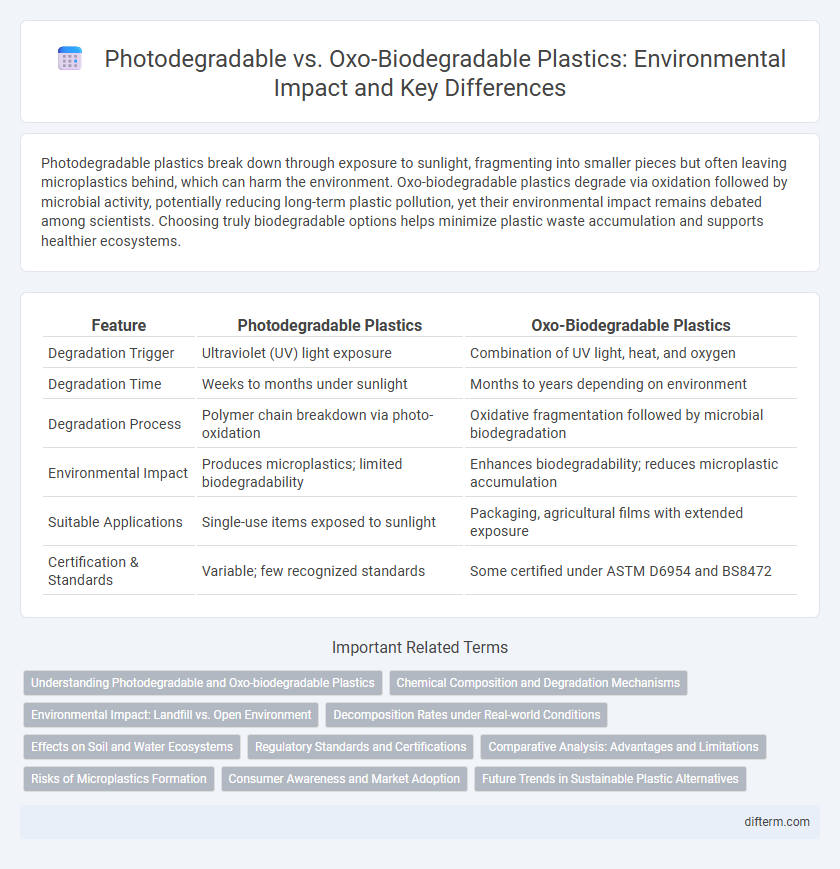Photodegradable plastics break down through exposure to sunlight, fragmenting into smaller pieces but often leaving microplastics behind, which can harm the environment. Oxo-biodegradable plastics degrade via oxidation followed by microbial activity, potentially reducing long-term plastic pollution, yet their environmental impact remains debated among scientists. Choosing truly biodegradable options helps minimize plastic waste accumulation and supports healthier ecosystems.
Table of Comparison
| Feature | Photodegradable Plastics | Oxo-Biodegradable Plastics |
|---|---|---|
| Degradation Trigger | Ultraviolet (UV) light exposure | Combination of UV light, heat, and oxygen |
| Degradation Time | Weeks to months under sunlight | Months to years depending on environment |
| Degradation Process | Polymer chain breakdown via photo-oxidation | Oxidative fragmentation followed by microbial biodegradation |
| Environmental Impact | Produces microplastics; limited biodegradability | Enhances biodegradability; reduces microplastic accumulation |
| Suitable Applications | Single-use items exposed to sunlight | Packaging, agricultural films with extended exposure |
| Certification & Standards | Variable; few recognized standards | Some certified under ASTM D6954 and BS8472 |
Understanding Photodegradable and Oxo-biodegradable Plastics
Photodegradable plastics break down through exposure to ultraviolet (UV) light, causing the polymer chains to fragment into smaller pieces, but they do not fully biodegrade in natural environments. Oxo-biodegradable plastics incorporate additives that catalyze oxidation, facilitating degradation by heat and oxygen, eventually leading to microbial assimilation under suitable conditions. Understanding the distinction between these materials is crucial for evaluating their environmental impact and designing effective plastic waste management strategies.
Chemical Composition and Degradation Mechanisms
Photodegradable plastics contain additives such as carbonyl groups that absorb UV light, triggering polymer chain scission and leading to fragmentation through photodegradation. Oxo-biodegradable plastics incorporate pro-oxidant additives, including metal salts like manganese or iron, which promote oxidative degradation by generating free radicals when exposed to heat and oxygen. The chemical composition of these plastics influences their degradation mechanisms, with photodegradable materials primarily relying on UV-induced bond cleavage and oxo-biodegradable materials undergoing oxidation followed by microbial biodegradation.
Environmental Impact: Landfill vs. Open Environment
Photodegradable plastics break down primarily through exposure to sunlight but may leave microplastic residues in open environments, posing long-term ecological risks. Oxo-biodegradable plastics contain additives that promote degradation via oxidation, accelerating fragmentation in landfills but potentially releasing harmful byproducts and incomplete degradation in natural settings. Landfill conditions often limit oxygen availability, reducing the effectiveness of oxo-biodegradable plastics and increasing environmental persistence compared to controlled photodegradation under sunlight.
Decomposition Rates under Real-world Conditions
Photodegradable plastics break down through exposure to sunlight, but their decomposition rates vary widely depending on UV intensity and weather conditions, often resulting in incomplete fragmentation. Oxo-biodegradable plastics incorporate additives that promote oxidation followed by microbial degradation, typically achieving faster breakdown within months to a few years in environments with oxygen and heat. Studies indicate that oxo-biodegradable plastics tend to decompose more reliably under real-world conditions than photodegradable plastics, which can persist as microplastics if UV exposure is insufficient.
Effects on Soil and Water Ecosystems
Photodegradable plastics break down into smaller fragments through sunlight exposure but often leave microplastics that persist in soil and water, posing risks to microbial communities and aquatic life. Oxo-biodegradable plastics undergo oxidative degradation triggered by oxygen and additives, resulting in fragmentation that can accelerate microbial assimilation, yet concerns remain about incomplete mineralization and accumulation of toxic residues. Both types impact soil fertility, water quality, and ecosystem health, necessitating thorough assessments of their environmental fate and long-term effects.
Regulatory Standards and Certifications
Photodegradable plastics often fail to meet stringent regulatory standards for biodegradability set by entities such as the European Union's EN 13432, which promotes compostable materials designed to fully break down without leaving microplastic residues. Oxo-biodegradable plastics are under increased scrutiny as regulators require evidence of complete biodegradation under specific conditions, with certifications from organizations like TUV Austria's OK Biodegradable range serving as benchmarks. Compliance with these certifications is critical for manufacturers to ensure market acceptance and environmental responsibility in the evolving landscape of sustainable plastic alternatives.
Comparative Analysis: Advantages and Limitations
Photodegradable plastics break down under UV light into smaller fragments but do not fully biodegrade, leading to microplastic pollution; oxo-biodegradable plastics incorporate pro-oxidant additives that trigger fragmentation followed by microbial degradation under specific environmental conditions. Photodegradable materials have advantages in controlled environments with ample sunlight but pose challenges in aquatic systems due to slow degradation and microplastic generation, whereas oxo-biodegradables offer enhanced biodegradability in diverse conditions but raise concerns about incomplete mineralization and potential toxicity of additives. The choice between these plastics depends on factors such as end-of-life environment, degradation timeline, ecological impact, and regulatory policies driving sustainable material management.
Risks of Microplastics Formation
Photodegradable plastics break down under UV light into smaller plastic fragments, leading to the formation of microplastics that persist in the environment and harm marine and terrestrial ecosystems. Oxo-biodegradable plastics also degrade through oxidation but fragment into microplastics before microbial assimilation occurs, raising concerns about incomplete biodegradation and long-term pollution. Both materials contribute to microplastic contamination that threatens wildlife, soil health, and water quality due to their slow and partial degradation processes.
Consumer Awareness and Market Adoption
Consumer awareness of photodegradable and oxo-biodegradable plastics remains limited, significantly impacting market adoption and environmental policy support. Studies show that photodegradable plastics degrade through sunlight exposure, whereas oxo-biodegradable plastics break down via chemical additives triggered by oxygen, creating confusion about their environmental benefits. Increased education on degradation processes and regulatory clarity are essential to boost consumer confidence and drive sustainable product demand in the packaging and plastic goods markets.
Future Trends in Sustainable Plastic Alternatives
Future trends in sustainable plastic alternatives emphasize the development of photodegradable and oxo-biodegradable materials that break down more efficiently under specific environmental conditions. Research is advancing toward enhancing the molecular design of these plastics to reduce microplastic pollution and accelerate decomposition without harmful residues. Innovations focus on integrating renewable resources and incorporating additives that trigger degradation processes aligned with ecological safety standards.
photodegradable vs oxo-biodegradable Infographic

 difterm.com
difterm.com